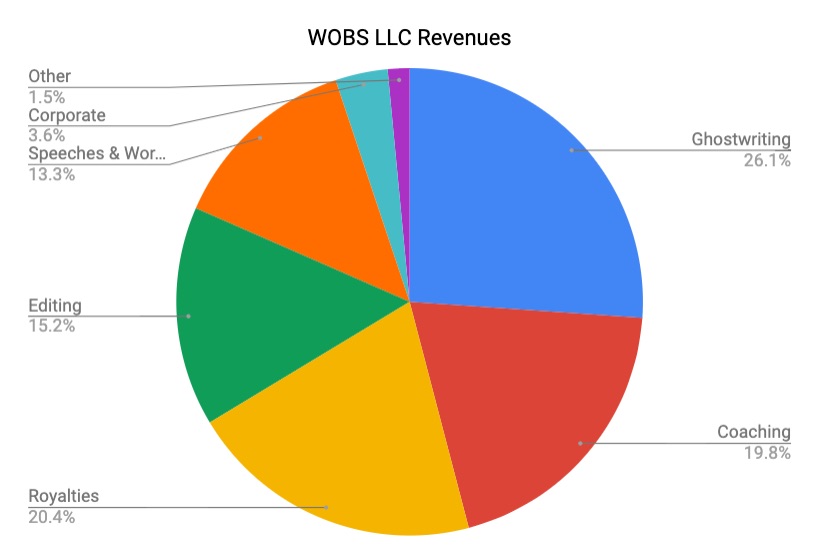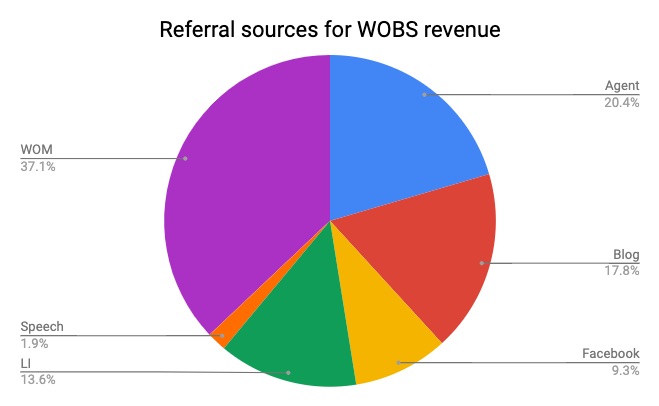A snapshot of my high-end writing and editing business
I’m now a little over four years into my corporate life as a freelance writer and editor. I try to be as transparent as possible. In that vein, today I’ll share a little of how I make a living, what works for me, and why.
The work: writing and editing pay the bills
In four years I have earned about three-quarters of a million dollars in revenue. Many authors are more successful than this; few editors are.

My revenue is a reflection of my successful ability to translate my prior work as an analyst and author into value for current clients. My best clients are those who value a writer or editor who brings an analyst’s perspective to business writing and marketing and technology trends.
Ghostwriting accounts for the largest portion of my income, at 26%. This includes both ghostwriting books and ghostwriting articles. I did not set out to ghostwrite books, but have found it to be both financially and emotionally rewarding.
I work a lot with authors. I make 20% of my income from book idea development, proposals, and coaching. I make another 15% from editing, much of which is book editing. Nothing is more enjoyable to me than helping authors find their voice.
In this time period, 20% of my revenue came from the advance on my book Writing Without Bullshit.
I get 13% of my revenue from speeches and workshops. While my business has shifted towards helping authors, I like to remain active with corporate clients and events to keep my content sharp.
High-level corporate copywriting — corporate identity work and value propositions — makes up 4% of my revenue. While I’ve enjoyed this work, it tends to take a lot of time and generate a lot of back-and-forth to deal with corporate politics. I’m good at this, but have to admit that I don’t have a unique talent or background for it. As a result, I will no longer pursue this kind of work.
In his excellent book Clarity Wins: Get Heard. Get Referred., Steve Woodruff suggests that every small business create a simple statement about who they serve and how, to make it easy to refer them. Steve would probably look at my business and tell me to dump everything but the service to authors. Now that I’ve been working long enough to know what I do, here’s my clarity statement:
Josh Bernoff helps business authors to succeed through writing, editing, and coaching.
The clients: marketing and technology leaders
Since March of 2015 I have had 63 clients and worked on 85 projects. The median size of a gig is $3,500, but the average is $6,495, because I have worked on a number of very large projects.
If I ignore the book advance, my largest client is Gotham Ghostwriters, a ghostwriting agency that has brought me several excellent opportunities including the writing of The Age of Intent. It has accounted for 22% of my revenue so far. My next-largest client is Selligent, for which I helped write Marketing to the Entitled Consumer. My next three biggest clients are authors. Together, my top five clients accounted for 43% of my revenues.
I enjoy having a mix of clients sizes. Small jobs fill the space between the big jobs. I don’t like the administrative overhead of many small jobs, but I don’t like having all my income tied up in a few large projects, so a mix like this is best.
Where the clients come from
How do people become clients?
I track the source of every referral. My book agent gets credit for the most revenue, since she got me the book contract. But looking at more traditional consulting gigs, good old word of mouth is still the largest source. Word of mouth generated 40% of my referrals and 37% of my revenue. Because my Gotham Ghostwriters relationship came through word of mouth, it looks very large in this analysis.

My blog delivered 31% of my referrals and 18% of my revenue.
Social media is another valuable source. I got 18% of my referrals and 9% of my revenue through Facebook, and 6% of my referral and 14% of my revenue through LinkedIn. (The LinkedIn revenue is inflated because it got me one of the two large ghostwriting gigs.)
Despite my 24,000 Twitter followers, Twitter has never generated a money-making referral for me.
Here’s my philosophy on marketing myself: It is important to be visible and put myself out there. This establishes a reputation for me. Among the group of authors I seek as clients, people tend to know who I am and what I do. This comes from the blog, Facebook, Twitter, LinkedIn, and word of mouth — they all contribute.
What this means for you
If you have a one-person freelance business, there are potential lessons here for you. There is no substitute for a broad personal network, but social media can extend the reach of that network. Do good work and people will pass on your name. And, as Steve Woodruff says, to succeed you need to develop a reputation for excellence in your specific pigeonhole of clients and work.
Content marketing is essential. Experts become known as experts through expert content. It’s not just about inbound traffic.
I’d add one more thing. You need to have an edge. You need to stand out. The penalty for that edge is you may lose a few people who find you too bold. But the penalty for seeming ordinary and inoffensive is much greater — that nobody will notice you.
Thanks for your candor here, Josh. It’s easy to fantasize about other people making millions and billions of dollars, even though it’s rare. Your pie chart is very revealing, and even though nobody else’s pie chart will be exactly the same, it’s instructive and motivating. I’m so glad I never got involved on Twitter… Thanks for taking the time to share this!